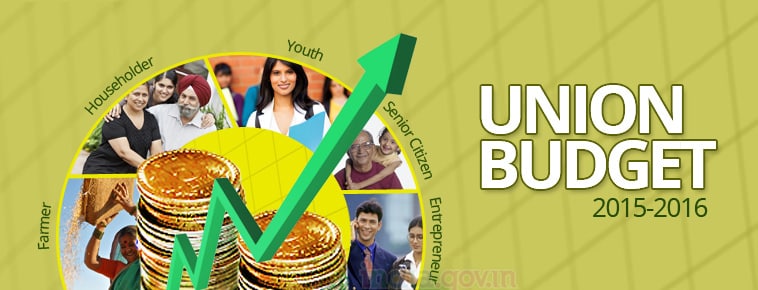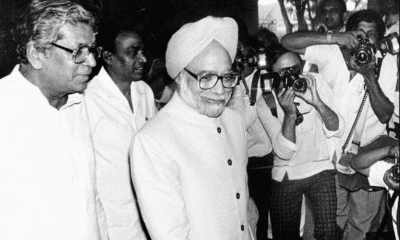Economy
Expert reaction on Budget 2016
Finance Minister Arun Jaitley presented the Union Budget 2016 on last day of Feb 2016.
Critics have acclaimed that the budget was pro-rural, giving a major push to the caretaker of our agricultural economy. There have been measures introduced, which is likely to double the income of farmers in the next five years. Then, there is pro-poor angle also, giving a tax break to 1 crore small tax payers.
On the economic front, the government has set a fiscal deficit target for next year at 3.5 percent of GDP. By keeping the fiscal deficit rate lower, the government is creating space for RBI to lower its policy rates further.
However, the government is still trying squeezing the maximum out of the middle and salaried class. The new cess for service tax is yet another move to make everything expensive for the aspirational class.
The government has not taken any major steps to incentivizing investments in India. The GST debate is still on in the parliament, and taxes have now gone up on companies, with a dividend of Rs 10 lakh and above. This brings in equity of taxation of direct income; however, the investment climate gets cloudy.
Raising money to address the agrarian distress is a welcome move. After all, 40% of our population is still residing in rural areas. Spends for infrastructure development such as roadways and railways has been increased to Rs 2.18 trillion in 2016-17.
In addition, rented house accommodates can now avail tax benefits for a deduction of up to 60,000. Larger tax payers will have to pay more with the income tax surcharge of 12 percent at present was increased to 15 percent for incomes exceeding Rs 1 crore per annum. A major step is in the direction on a tax break for first time home buyers. For them buying property priced 5o lakh onwards, will help them avail an interest exemption on their loans up to Rs 35 lakh, under section 80EE (interest exemption increased from Rs 1.5 lakh from Rs 1 lakh), This will supplement growth in the real estate sectors where 40% of supply is in this price bracket.
Two major issues still remain to be addressed appropriately; one how will the PSU’s be revived-only recapitalization of the banks is an ambiguous proposal. The major funding source for roads is to come from the PSU’s. There is no clear cut approach to a ‘Digital India’ yet.
We get you some reactions from the experts in India.
RADHIKA RAO, ECONOMIST, DBS, SINGAPORE
“It is encouraging to see that fiscal discipline has been given priority at today`s budget, though we await the fine-print. Budgetary assumptions, especially nominal GDP growth will be key. Implementation of the pay commission proposals is also unclear in the speech, so more details are also sought here. Focus on rural/ social sector spending and roads/ highways are along expected lines and positive. But less-than-expected support for banks` recapitalization has disappointed. Services tax was left unchanged and long-term capital gains tax fears were left misplaced.”
ADITI NAYAR, SENIOR ECONOMIST, ICRA, NEW DELHI
“Sticking to 3.5 pct of the fiscal deficit target reinforces the credibility of Government of India`s medium term fiscal targeting. The expenditure priority outline is also within our expectations, including the focus on rural, farmer and infrastructure. Monetisation through divestment of (central public sector enterprises`) individual assets would augment funds for investments, and improving the target of beneficiaries for various subsidies through greater use of Aadhar is expected to result in fiscal savings over the medium term. And we welcome the move to do away with the plan, non-plan classification from FY18 onwards.”
AMITABH DUBEY, DIRECTOR, INDIA RESEARCH AT TRUSTED SOURCES, NEW DELHI
“We will have to see how they managed to hold on to the deficit target, which is a positive, while raising capital spending and rural spending.”
“At first sight, it`s a good budget, a fire-fighting budget. Rural demand is weak, private investment is dead in the water and of course we have a banking crisis.”
“They`ve announced some ease of doing business measures that are positive. But in other ways, it`s a classic tax-and-spend budget.”
Rakesh Valecha, Head – Credit & Market Research, India Ratings & Research
The budget has focussed specifically on the rural sector, roads and railways. Focus on roads and railways will help create a multiplier impact on demand and help improve capacity utilisations, however, a meaningful increase in private capital expenditure is unlikely to happen before FY19.
The ability to meet all outflows is also contingent on a significant increase in non-tax revenues from divestment of telecom spectrum (INR990bn) and divestment proceeds from strategic assets (INR556bn) coupled with a growth in tax revenues both on the direct and indirect side.
Direct tax increases, particularly on Corporate tax look particularly optimistic and may face disappointment as the year progresses given that our earnings growth estimates for BSE500 Corporates for the period remains in single digit .
While the Budget was devoid of any headline grabbing measures, it is the best possible that could have been achieved in the present environment.
Chandra Shekhar Ghosh, Bandhan Bank: Biggest take away is commitment to fiscal consolidation
The Budget for fiscal year 2016-17 has brought back the focus to rural economy and rightly so as this segment has been experiencing a tough time following two years of insufficient monsoon. The biggest take away from this budget is Finance Minister Arun Jaitley’s commitment to the path of fiscal consolidation.
There was pressure on him to have an expansionary budget targeting growth but he has not compromised on fiscal discipline even as his focus remained on growth, driven by domestic demand and a slew of reforms.
It has equal emphasis on the firm sector, creation of jobs as well as infrastructure. Finally, this Budget is as much about ease of doing business in India as ease of paying taxes.
VISA Steel MD Vishal Agarwal – Steel sector
The Union Budget 2016 has been extremely disappointing for the steel sector. Commenting on specific issues concerning the industry, he said while it was expected that import duty on coking coal of 2.5% would be removed, no such measure was announced in the budget. The Clean Energy Cess (renamed as Clean Environment Cess) has been increased from Rs. 200 per tonne to Rs. 400 per tonne.
Pranav Sayta, EY India: Budget seeks to introduce a paradigm shift in the Corporate Tax Regime
The Budget seeks to introduce a paradigm shift in the Corporate Tax Regime by finally seeking to start implementing the move towards a “simplified” tax regime by phasing out deductions & exemptions & with lower Corporate Tax rates. Apart from reducing scope for litigation in future, this could effectively create a more level playing field for Corporates with minimal tax differential irrespective of the sectors (for instance Infrastructure, renewables) or geographies (for instance backward area incentives) in which they operate, the nature of income earned (for instance Foreign Exchange earnings), the nature of activity (for instance R&D) etc.
The deferral of POEM by a year especially given the delay in the Guidelines demonstrates once again the Governments intent to bring in a sense of fairness in the tax regime. One would similarly expect that if indeed GAAR is to become effective from 1 April 2017, the relevant steps for ensuring preparedness be taken forthwith including issue of detailed draft Guidelines.
While some of the Eashwar Committee recommendations have been incorporated, more could have been achieved (for instance deferral of ICDS). The proposed introduction of the Equalisation Levy may be a significant step especially in view of the ongoing global debate in regard to Taxation of the Digital Economy.
Ranen Banerjee, Leader Public Finance and Economics, PwC India
A fine reading reveals that FM has been able to manage this through continued excise duties on petroleum products, a lower than envisaged provision for bank recapitalization of 25,000 crore, and a possible delay and moderation of the 7th Pay Commission recommendations by leaving the decision to a panel.
Moody’s views on Budget 2016: Government has underscored commitment to fiscal consolidation
> From a sovereign credit perspective, we were interested in how India’s budget answered three key questions. First, whether the trend of falling annual fiscal deficits would be maintained in FY 2016 estimates and FY 2017 targets. Second, how the allocation of government resources towards civil servant pay hikes, and bank recapitalization would affect FY 2017 budget targets. And third, whether new measures to address India’s structural challenges over the medium term would be introduced.
> On the first issue, the budget has maintained its fiscal deficit targets, underscoring a commitment to fiscal consolidation. But, as expected, consolidation will be gradual, challenging and vulnerable to adverse economic trends.
> On the second, the implementation of the 7th pay commission is likely to be the key additional source of spending pressure in FY 2017. The amount allocated to the recapitalization of banks was not as high as some market estimates. On the revenue side, there were some modest offsetting revenue measures (such as the listing of state-owned insurance firms). But on balance, meeting the deficit target of 3.5% of GDP will remain challenging.
> On new initiatives: While there were several measures announced on both the revenue and expenditure front, none heralded a structural shift in the fiscal or macro-economic framework. Still, if effectively implemented, the streamlining of tax compliance and administration and simplifying tax rates could support the investment outlook, and the government’s “Make in India” push. Rural spending measures were not surprising given the socio-economic impact of two successive years of a weak monsoons.
> Looking ahead, the FY 2016/17 budget target appears to recognize that pressures on the expenditure side are mounting, given the significant costs of funding government employee wages and benefits, as well as bank recapitalization costs.
Sachin Menon, Partner and Head of Indirect Tax, KPMG India
In line with the Make In India initiative, changes have been made in customs and excise duty rates on certain inputs to reduce costs and improve competitiveness of certain domestic industries like Information technology hardware, capital goods, defence production, etc.
On the flip side, instead of abolishing Swatch Bharat cess to as a precursor to GST, an additional new cess by the name Krishi Kalyan Cess is proposed to be levied @ 0.5% on all taxable services (whose credit would be admissible for payment of output cess), taking gross service tax to 15% from 1 June 2016 onwards.
Statements from Naveen Aggarwal, Partner – Tax, KPMG in India
On Tax simplification
Justice Easwar Committee’s recommendations for simplification of tax laws has found favour with the FM. Extending the limit of presumptive scheme to taxpayers with annual turnover of Rs 2 crores from present limit of Rs 1 crore is a welcome step.
On Penalty
Simplification of penalty provisions is a welcome move and showcases government’s intention of simplifying and bringing certainty in tax laws.
On Retrospective Taxation
Retrospective amendments not to be made going forward; special regime to settle past disputes on indirect transfer tax, showcases Government’s commitment towards creating a stable and predictable tax regime in India.
On GAAR
Government has reaffirmed its commitment to making GAAR effective from 1 April 2017. This is likely to align Indian tax laws with legislation of BEPS action plans
K Ravichandran, senior VP, Co-head, Corporate Sector Ratings, ICRA
Subsidy provided for the oil sector is Rs 26947 Cr for 2016-17, which ICRA believes will be sufficient to meet the subsidy for fiscal year 2016-17. Because of significant fall in gross under recoveries for the sector, there may not be any need to carry forward the last quarter subsidy if the oil prices stay below @40/bbl.
This will be positive for the OMCs who will be getting the subsidy in a timely manner thereby, saving on the interest cost on short term borrowings. The budget gives a relief to the upstream companies in terms of change in levy of cess from specific rate (Rs 4500/MT or ~$9/bbl now) to an advalorem rate of 20%, who stand to gain ~$3/bbl at the current oil prices.
Rajeev Dimri, leader, indirect tax, BMR & Associates LLP
“On the taxation front, the focus on dispute resolution through creation of new tribunal benches, alternative settlement schemes and commitment to refrain from retrospective taxation going forward was encouraging and progressive.
However, their efficacy would need to be evaluated based on the fine print of the associated regulations.







































